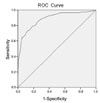1. Korean National Statistical Office. 2005.
2. Harris MI, Klein R, Welborn TA, Knuiman MW. Onset of NIDDM occurs at least 4-7 yr before clinical diagnosis. Diabetes Care. 1992. 15:815–819.
3. Klein R, Klein BEK, Moss SE, Davis MD, DeMetz DL. The Wisconsin epidermiologic study of diabetic retinopathy. III. prevalence and risk of diabetic retinopathy when age at diagnosis is 30 or more years. Arch Opthalmol. 1984. 102:527–532.
4. Harris MI. Undiagnosed NIDDM; Clinical and public health issues. Diabetes Care. 1993. 16:642–652.
5. Ballard DJ, Humphrey IL, Melton LJ, Fronhnert PP, Chu PC, O'Fallon WN. Epidemiology of persistent proteinuria in type II diabetes mellitus. Population-based study in Rochester, Minnesota. Diabetes. 1988. 37:405–412.
6. Harris MI. Impaired glucose tolerancee in the U.S. population. Diabetes Care. 1989. 12:464–474.
7. UK Prospective Diabetes Study (UKPDS) Group. Intensive blood-glucose control with sulphonylureas or insulin compared with conventional treatment and risk of complications in patients with type 2 diabetes (UKPDS 33). Lancet. 1998. 352:837–853.
8. ADA International Expert Committee. Report of the Expert Committee on the diagnosis and classification of diabetes mellitus. Diabetes Care. 1997. 20:1183–1197.
9. The DECODE Study Group. Is fasting glucose sufficient to define diabetes? Epidemiological data from 20 European studies. Diabetologia. 1999. 42:647–654.
10. The DECODA Study Group. The fasting plasma glucose cut-point predicting a diabetic 2-h OGTT glucose level depends on the phenotype. Diabetes Res Clin Pract. 2002. 55:35–43.
11. Show JE, Boyko EJ, Courten M, Zimmet PZ. Impact of new diagnostic criteria for diabetes on different population. Diabetes Care. 1999. 22:762–766.
12. Baik SH, Choi KM, Cho YJ, Kim KO, Kim DR, Kim NH, Kim SG, Shin DH, Park LB, Choi DS. Prevalence of Diabetes mellitus in Elderly Korean in Southwest Seoul (SWS Study) - Comparision of 1997 ADA &1985 WHO Criteria in Elderly Korean. J Korean Diabetes Assoc. 2001. 25:125–132.
13. The Expert Committee on the Diagnosis and Classification of Diabetes Mellitus. Follow-up report on the diagnosis of diabetes mellitus. Diabetes care. 2003. 26:3160–3167.
14. World Health Organization. Definition, Diagnosis and Classification of Diabetes Mellitus and its Complications. Part 1: Diagnosis and Classification of diabetes mellitus. Report of a WHO Consultation. 1999. Geneva: World Health Organigation.
15. McCance DR, Hanson RL, Pettitt DJ, Bennett PH, Hadden DR, Knowler WC. Diagnosing diabetes mellitus: Do we need new criteria? Diabetologia. 1997. 40:247–255.
16. Gómez-Pérez FJ, Aguilar-Salinas CA, López-Alvarenga JC, Perez-Jauregui J, Guillen-Pineda LE, Rull JA. Lack of Agreement Between the World Health Organization Category of Impared Glucose Tolerance and the American Diabetes Association Category of Impaired Fasting Glucose. Diabetes Care. 1998. 21:1886–1888.
17. Unwin N, Alerti KG, Bhopal R, Harland J, Watson W, White M. American Diabetes Association. Comparison of the current WHO and new ADA criteria for the diagnosis of diabetes mellitus in three ethnic groups in the UK. Diabet Med. 1998. 15:554–557.
18. Sadikot SM, Nigam A, Das S, Bajaj S, Zargar AH, Prasannakumar KM, Sosale A, Munichoodappa C, Seshiah V, Singh SK, Jamal A, Sai K, Sadasivrao Y, Murthy SS, Hazra DK, Jain S, Mukherjee S, Bandyopadhay S, Sinha NK, Mishra R, Dora M, Jena B, Patra P, Goenka K. Comparing ADA 1997 and the WHO 1999 criteria: Prevalence of Diabetes in India study. Diabetes Res Clin Pract. 2004. 66:309–315.
19. Oh JY, Lim S, Kim DJ, Kim NH, Kim DJ, Moon SD, Jang HC, Cho YM, Song KH, Park KS. Committee of the Korean Diabetes Association on the Diagnosis and Classification of Diabetes Mellitus. The diagnosis of diabetes mellitus in Korea: a pooled analysis of four community-based cohort studies. Diabet Med. 2007. 24:217–218.
20. Oh JY, Lim S, Kim DJ, Kim NH, Kim DJ, Moon SD, Jang HC, Cho YM, Song KH, Ahn CW, Sung YA, Park JY, Shin C, Lee HK, Park KS. Committee of the Korean Diabetes Association on the Diagnosis and Classification of Diabetes Mellitus. A report on the diagnosis of intermediate hyperglycemia in Korea: a pooled analysis of four community-based cohort studies. Diabetes Res Clin Pract. 2008. 80:463–468.
21. Kim DJ, Chung YJ, Oh EY, Hahm JR, Kim BJ, Kim SH, Kim KA, Chung JH, Min YK, Lee MS, Lee MK, Kim KW. The Appropriteness of New ADA Diagnostin Criteria for Diabetes Mellitus in Korean Population. J Korean Diabetes Assoc. 1999. 23:336–351.
22. Kim SG, Yang SW, Choi SI, Park SH, Lee KR, Park JH, Jang AS, Seo JP, Lee S, Nam HS, Sun MH, Shin MG, Chung DJ, Chung MY. Prevalence of diabetes mellitus in the elderly of Namwon county, South Korea. Korean J Med. 2001. 60:555–566.
23. Tanaka Y, Matsuoka K, Atumi Y, Kinoshita J, Asahina T, Onuma T, Hosokawa K, Kawamori R. Usefulness of revised fasting plasma glucose criterion and characteristics of the insulin response to an oral glucose load in newly diagnosed Japanese diabetic subjects. Diabetes care. 1998. 21:1133–1137.
24. Chang CJ, Wu JS, Lu FH, Lee HL, Yang YC, Wen MJ. Fasting plasma glucose in screening for diabetes in the Taiwanese population. Diabetes Care. 1998. 21:1856–1860.
25. Lee CH, Fook-Chong S. Evaluation of fasting plasma glucose as a screening test for daibetes mellitus in Singaporean adults. Diabetic Med. 1997. 14:119–122.
26. Mioko G, Naoki S, Isao K, Shigeaki S, Ken-ichi S, Makoto T, Shoji K, Hideyo Y, Kazuyo T, Juichi S, Yuzo S, Satoru T, Toshihide Y, Yutaka S, Takeshi U, Kishio N, Mari H, Kazuhiko K, Arimasa H, Yutaka K, Hideshi K. Effect of sex, age and BMI on screening tests for impaired glucose tolerance. Diabetes Res Clin Pract. 2004. 64:129–136.
27. Jeong IK, Moom MK, Kim SW, Park YJ, Kim SY, Shin CS, Park DJ, Park KS, Kim SY, Cho BY, Kim NK, Lee HK. Comparison of Clinical Characteristics of Impaired Fasting Glucose with Impaired Glucose Tolerance in Yonchon County. J Korean Diabetes Assoc. 2000. 24:71–77.
28. Kim SM, Yoon DK, Lee JS, Baik SH, Lee J, Choi DS, Na JK, Choi KM, Han JH. Prevalence of diabetes and impaired fasting glucose in Korea. Diabetes Care. 2006. 29:226–231.












 PDF
PDF ePub
ePub Citation
Citation Print
Print


 XML Download
XML Download